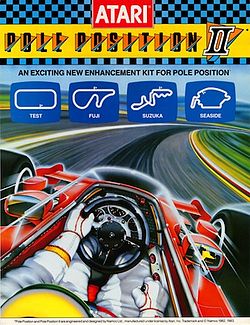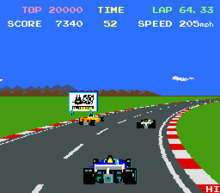Pole Position II
The digital 80's
I loved games, and in my infancy I used to be an "adult playing observer", passing hours watching people inserting 25 peseta coins for additional lifespan in Gauntlet, or trying to consume all Out Run's in-game melodies and the colorful USA-wide scroll. Defender, Space Invaders, Galaxian or Donkey Kong are the first ones I remember, full of charm, in bars, mini-golf resources, or swimming pools near León, with a delicious smell to tapas.
Pole Position II is a racing arcade game that was released by Namco in 1983 as the sequel to Pole Position, which was released the previous year. As with the original, Namco licensed Pole Position II to Atari for US manufacture and distribution. Atari also released Pole Position II as the pack-in game for their Atari 7800 Prosystem console.
There is a new opening theme, and in addition to the original Fuji racetrack, there are three others to choose from: Test (resembling Indianapolis Motor Speedway), Seaside (resembling 1982 United States Grand Prix West circuit in Long Beach), and Suzuka. The graphics were improved; cars have a different color scheme and explosions show debris. Wheel spin has also been added to the game. One notable difference between the Japanese and U.S. versions is that while the timer is displayed as "TIME" in the Japanese version (as with the previous game), it is displayed as "UNIT" in the U.S. release.
Pole Position II appears in various Namco Museum collections, but presumably due to licensing issues, Fuji Speedway and Suzuka Circuit were renamed Namco Circuit and Wonder Circuit (after Namco's "Wonder" series of Japanese theme parks), respectively. In Namco Museum Virtual Arcade, they were renamed Blue and Orange respectively.
Keywords:
1982 United States Grand Prix West
Aguri Suzuki F-1 Super Driving
Al Unser Jr.'s Turbo Racing
Arcade game
Arcade system board
Atari
Atari 7800
Ayrton Senna's Super Monaco GP II
Central Processing Unit
Chequered Flag (video game)
Commodore 64
Computing platform
Continental Circus
EA Sports F1 series
F-1 (arcade game)
F-1 Dream
F-1 Grand Prix (video game series)
F-1 Hero MD
F-1 Pilot
F-1 Race
F-1 Sensation
F-1 Spirit (series)
F-1 World Grand Prix
F-1 World Grand Prix II
F1 (video game)
F1 2009 (video game)
F1 2010 (video game)
F1 2011 (video game)
F1 2012 (video game)
F1 Challenge
F1 Circus
F1 Circus (series)
F1 Circus MD
F1 Grand Prix (2005 video game)
F1 Pole Position (video game)
F1 Pole Position 2
F1 Pole Position 64
F1 Race Stars
F1 Racing Championship
Fastest 1
Final Lap
Final Lap 2
Final Lap 3
Final Stretch (video game)
Formula 1 (video game)
Formula 1 97
Formula 1 98
Formula One
Formula One (1985 video game)
Formula One 04
Formula One 05
Formula One 06
Formula One 2000 (video game)
Formula One 2001 (video game)
Formula One 2002 (video game)
Formula One 2003 (video game)
Formula One 99
Formula One Arcade
Formula One Championship Edition
Formula One Grand Prix (video game)
Formula One video games
Fuji Speedway
GP Challenge
Grand Prix 2
Grand Prix 3
Grand Prix 4
Grand Prix Challenge
Grand Prix Circuit (video game)
Grand Prix Legends
Grand Prix Manager
Grand Prix Manager (1984 video game)
Grand Prix Manager 2
Grand Prix World
Indianapolis Motor Speedway
Japan
MS-DOS
Michael Andretti's World GP
Mobile Phone
Monaco GP (video game)
Monaco Grand Prix (video game)
Nakajima Satoru F-1 Hero '94
Namco
Namco Bandai Games
Namco Museum
Namco Networks
Namco Pole Position
Nigel Mansell's World Championship Racing
North America
Overtake (video game)
Pole Position (video game)
Pole Position II
Racing Simulation 2
Racing video game
Raster graphics
Satoru Nakajima F-1 Hero 2
Satoru Nakajima F-1 Hero GB World Championship '91
Single-player
Super F-1 Hero
Super F1 Circus
Super Monaco GP
Suzuka Circuit
TX-1
Tail to Nose
Video game developer
Video game genres
Video game publisher
World Grand Prix (video game)
Content extracted from Wikipedia, where you can find its license details.
Ignacio Javier Gómez Rodríguez (igjav). OS developer. Naive power.



